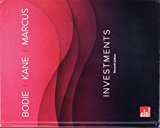
a.
To draw: A payoff graph depicting the strategy of given information.
Introduction:
Payoff graph: It is supposed to be a graphical representation of potential outcomes of a strategy. The vertical axis depicts the
b.
To draw: A profit graph depicting the strategy of given information.
Introduction:
Profit graph: It can also be called as risk graph. Profit graph is supposed to be visual depiction on possible outcomes of an options strategy on a graph. On the vertical axis, the profit/loss is depicted whereas the horizontal axis depicts the underlying stock price on expiration date.
c.
To analyze: Whether the portfolio has positive beta or negative when the underlying stock has positive beta.
Introduction:
Positive beta: Normally beta (ß) is used to measure the volatility of investment returns which are related to the whole market. When a stock values goes in the same direction in which the market prices are moving, it is said to be a positive beta.
Trending nowThis is a popular solution!

Chapter 20 Solutions
Investments, 11th Edition (exclude Access Card)
- The value of an investment grows from $10,000 to $15,000 in 3 years. What is the CAGR?Soovearrow_forwardSuppose that the treasurer of IBM has an extra cash reserve of $100,000,000 to invest for six months. The six-month interest rate is 9 percent per annum in the United States and 8 percent per annum in Germany. Currently, the spot exchange rate is €1.07 per dollar and the six-month forward exchange rate is €1.05 per dollar. The treasurer of IBM does not wish to bear any exchange risk. Where should they invest to maximize the return? Required: The maturity value in six months if the extra cash reserve is invested in Germany:arrow_forwardThe value of an investment grows from $10,000 to $15,000 in 3 years. What is the CAGR?arrow_forward
- You invest $5,000 in a project, and it generates $1,250 annually. How long will it take to recover your investment?arrow_forwardA company pays an annual dividend of $3 per share, and the current stock price is $50. What is the dividend yield?arrow_forwardYou invest $1,000 in a stock, and after 2 years, it grows to $1,200. What is the annual return?arrow_forward
- You invest $1,000 in a stock, and after 2 years, it grows to $1,200. What is the annual return? Exparrow_forwardWells and Associates has EBIT of $ 72800. Interest costs are $ 18400, and the firm has 15600 shares of common stock outstanding. Assume a 40 % tax rate. a. Use the degree of financial leverage (DFL) formula to calculate the DFL for the firm. b. Using a set of EBIT -EPS axes, plot Wells and Associates' financing plan. c. If the firm also has 1200 shares of preferred stock paying a $ 5.75 annual dividend per share, what is the DFL? d. Plot the financing plan, including the 1200 shares of $ 5.75 preferred stock, on the axes used in part (b). e. Briefly discuss the graph of the two financing plans.arrow_forwardYou invest $5,000 for 3 years at an annual interest rate of 6%. The interest is compounded annually. Need helparrow_forward
- What is the future value of $500 invested for 3 years at an annual compound interest rate of 4%? Explarrow_forwardYou invest $5,000 for 3 years at an annual interest rate of 6%. The interest is compounded annually.arrow_forwardWhat is the future value of $500 invested for 3 years at an annual compound interest rate of 4%?arrow_forward
 EBK CONTEMPORARY FINANCIAL MANAGEMENTFinanceISBN:9781337514835Author:MOYERPublisher:CENGAGE LEARNING - CONSIGNMENT
EBK CONTEMPORARY FINANCIAL MANAGEMENTFinanceISBN:9781337514835Author:MOYERPublisher:CENGAGE LEARNING - CONSIGNMENT Intermediate Financial Management (MindTap Course...FinanceISBN:9781337395083Author:Eugene F. Brigham, Phillip R. DavesPublisher:Cengage Learning
Intermediate Financial Management (MindTap Course...FinanceISBN:9781337395083Author:Eugene F. Brigham, Phillip R. DavesPublisher:Cengage Learning

